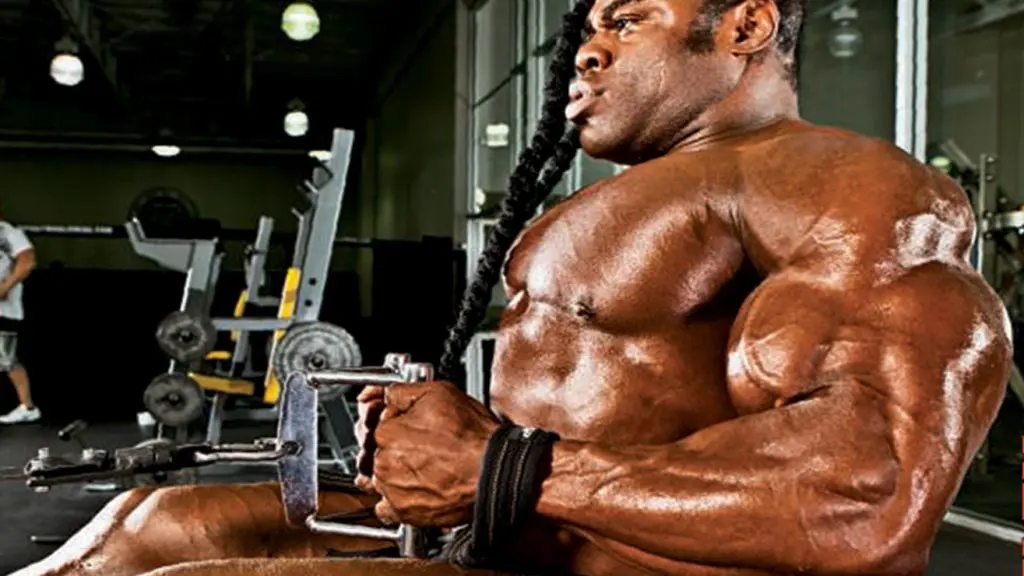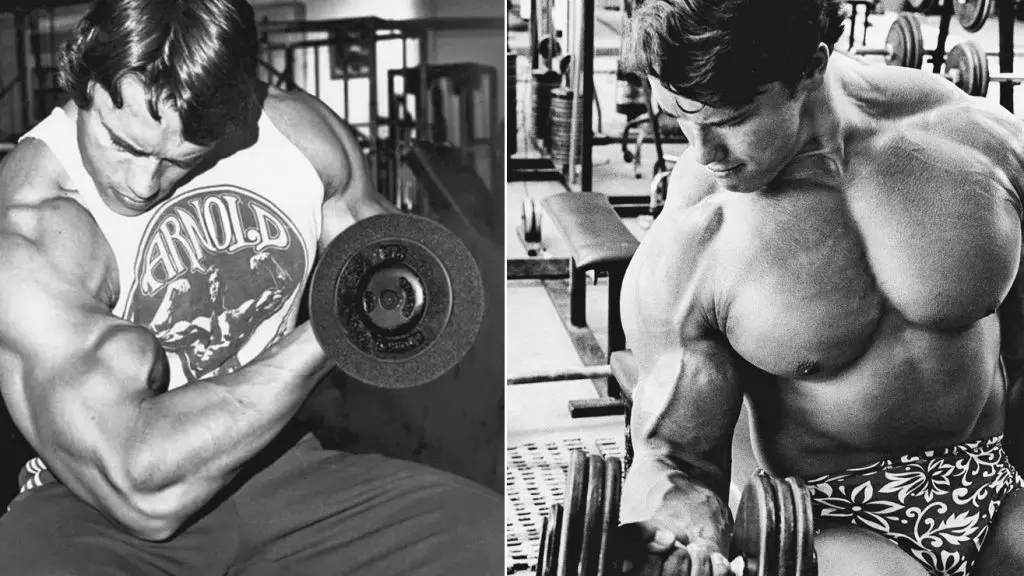Whether you’re an athlete or someone who just wants to put on serious size and get really strong too; you can benefit from a power building routine!
If you thought the name “Powerbuilding” meant a hybrid between powerlifting and bodybuilding… well, you were right!
However, if you’ve never heard of it before it doesn’t mean it never existed because it’s actually a fairly common training method for those who want to develop both size and strength.
The idea here is to utilize compound/power movements to increase strength (You’ll still gain muscle size) while still using a bodybuilding-focused routine for strictly size gains.
If you’d like to benefit from power building, then make sure to take notes…
What Exactly is Power building?
Every serious athlete and/or gym-goer understands that a strong base is a must for achieving maximum results and progressing in the gym.
The concept of power building is to maximize your genetic potential through strategically training in a manner that will allow you to lift heavy (Compound lifts) first and focus on accessory/isolation lifts second.
Level Up Your Fitness: Join our 💪 strong community in Fitness Volt Newsletter. Get daily inspiration, expert-backed workouts, nutrition tips, the latest in strength sports, and the support you need to reach your goals. Subscribe for free!
To start, you’ll basically structure your routine like a powerlifter, using heavy weights and low reps (3-6) followed by bodybuilding/aesthetic type training in the same training session, which requires moderate to higher repetitions (8-15) and moderate resistance.
The good thing is that powerlifting movements help with bodybuilding movements and vice versa. The body needs a balance of training variations in order to work in an optimally synergistic manner.
You have to get stronger to get bigger and there’s no way around it!
After you become more advanced, you can, of course, tailor your routine more specifically to your needs.
How you decide to do it… is up to you. You can choose to do a split, go for upper/lower, or train full body. However, you must have a plan because power building is a serious matter not to be taken lightly (Pun intended).
Developing a routine which suits you will require an assessment (Done by someone or you) and as you progress, you’ll need to change it up periodically.
How to Structure the Perfect Routine
Structuring a power building routine does not have to be difficult and depending on your current level of fitness, you can determine where to start.
Based on your training experience (Beginner, intermediate or advanced) you can structure your routine and find your starting point.
Note: Warm-up sets are not included. Always make sure to warm-up properly to prevent injuries and gradually increase the resistance per each exercise (Start with a light to moderate weights before jumping into heavy lifts).
These general guidelines will help you to get started safely and effectively:
Beginner Routine (6 months or less)
A beginner starts by discovering how his/her body responds to training by learning as much as possible and building a base while experimenting with different techniques and movements. This is a “very important step” and is not to be skipped.
This is why it’s recommended to lift moderately heavy rather than extremely heavy as injuries are more likely in the beginning stages of training.
Here’s a beginner’s general power building routine outline.
- Training frequency – 3 days per week
- Power movements – squats, deadlifts, bench press, Military (Shoulder) press (3 sets of 8-10 reps per movement).
- Isolation/Accessory movements 3-4 (3 sets of 12-15 reps)
Intermediate Routine (6 Months – 2 Years Consistent Training)
An intermediate lifter has begun to understand how their bodies react to certain exercises and set/rep ranges. At this stage in training, mind/muscle connection is much better than when a lifter is new (Beginner) to training. This allows for the workouts to be more effective and the muscles receive proper stimulus while avoiding injury.
Here’s an intermediate general power building routine outline.
- Training frequency – 4 days per week
- Power movements – squats, deadlifts, bench press, rows, Military (Shoulder) press (4 sets of 4-8 reps per movement).
- Isolation/Accessory movements 4 (4 sets of 10-12 reps)
Advanced Routine (2+ Years of Consistent Training)
An advanced lifter knows exactly how to train (Although we never stop learning) and is confident in what will or will not work for them regarding a power building routine. Advanced lifters know the frequency and volume to train with to achieve optimal results for themselves.
An advanced lifter should know how to tweak a routine to their liking but here’s a general advanced power building routine outline to start with.
- Training frequency 4-5 days per week
- Power movements – squats, deadlifts, bench press, rows, Military press, pull-ups (Weighted if necessary) (5 sets of 3-5 reps)
- Isolation /Accessory movements 4-5 (4 sets 8-12 reps)
- Additional day –Isolation/Accessory movements (Fullbody)
Results You Can Expect From a Powerbuilding Routine…
Goodness, the possibilities are endless! Let’s see…
Significant Strength Gains
A study showed that high-intensity training (3-5 RM) with low volume and longer rest periods results in a greater one-rep max and hypertrophy compared to training with moderate intensity, higher volume and shorter rest periods. This study was however performed on trained men in an 8-week training program.
Now the results were short term but muscle gains were indeed better with higher intensity and low volume than with moderate reps and higher volume for the subjects.
However, for long-term muscle gains, higher volume and shorter rest periods are more necessary for building “aesthetics” and continuing to see maximum hypertrophy.
Maximum Muscle Gains
The process of building strength in an effort to put on more size is accurate of how you train with a power building routine. A variety in rep ranges is important for a bodybuilder. Many believe that a rep range of 8-12 (Moderate) is the only way to train but you’d be limiting your potential by not training with lower rep ranges (3-6) and higher rep ranges. (15).
Better Stability and Mobility
The strength and isolation movements involved in a powerbuilding routine contribute to a stronger core and stabilizer muscles, which assist in lifting and balance, while improving overall mobility.
A compound movement like the squat will allow for improved mobility around hips and ankles.
Powerbuilding Routine for Every Level of Fitness
Here’s a sample power building routine below that you can use or get an idea from to make your own routine.
Anyone can use a similar routine but the only thing which usually changes is the resistance based on your strength and endurance as well as the increase in volume, the more advanced you become.
This routine can suit a beginner as far as sets and reps but intermediate to advanced lifters can add an extra set and/or increase the resistance to perform lower reps.
Level Up Your Fitness: Join our 💪 strong community in Fitness Volt Newsletter. Get daily inspiration, expert-backed workouts, nutrition tips, the latest in strength sports, and the support you need to reach your goals. Subscribe for free!
For isolation moves, use shorter rest periods between sets (30-60 seconds).
For power moves, use longer rest periods between sets (3-5 minutes).
Studies show these to be the ideal rest times between sets for maximum effectiveness in achieving strength and/or muscle growth.
Example Workout Routine Suitable for a Beginner:
Feel free to adjust any part of this routine to your comfort and safety levels according to your body.
These compound movements are preferred as they work for the larger muscle groups most effectively and the isolation exercises will help you with your big lifts but will also stimulate different muscle fibers due to the variation in rep ranges.
Remember, as a beginner, it’s crucial to start relatively slow and not go too heavy at first because your tendons, ligaments, and muscles have to adjust to the new stresses being place on them.
Get the technique down first and ask for help from someone with more experience if necessary. Safety is always the first priority.
Day 1
Lower Body (Building)
- Squats 3 x 8-10 (Rest 60 seconds)
- Lunges 3 x 12-15 (Rest 30-60 seconds)
- Barbell hip thrusts 3 x 12-15 (Rest 30-60 seconds)
Day 2
Upper Body (Building)
- Bench 3 x 8-10 (Rest 60 seconds)
- Incline dumbbell press 3 x 12 (Rest 60 seconds)
- E-Z curl barbell overhead tricep extensions 3 x 12 (Rest 30-60 seconds)
- V-bar cable pulldowns 3 x 12 (Rest 30-60 seconds)
- Dumbbell seated incline curls 3 x 12 (Rest 30-60 seconds)
Day 3
Lower Powerbuilding
- Deadlift 3 x 6 (Rest 3-5 minutes)
- Seated rows 3 x 10 (Rest 60 seconds)
- Dumbbell hammer curls 3 x 10 (Rest 30-60 seconds)
- Face pulls 3 x 10 (Rest 30-60 seconds)
- Rope pushdowns 3 x 10 (Rest 30-60 seconds)
Day 4
Upper Powerbuilding
- Military press 3 x 8 (Rest 3-5 minutes)
- Dumbbell chest press 3 x 10 (Rest 60 seconds)
- V-bar pushdowns 3 x 10 (Rest 30-60 seconds)
- Straight bar pulldowns 3 x 10 (Weighted if you can do more than 10 reps) (Rest 30-60 seconds)
- Barbell Curls 3 x 10 (Rest 30-60 seconds)
Example Workout Routine Suitable for Intermediate and Advanced Lifters:
Since an intermediate and advanced lifter has the luxury of knowing more so how to manipulate a program to work perfectly for them, nothing much else needs to be said.
Proper form and safety are really the only concerns here but warming up thoroughly and good lifting technique will prevent any injuries.
An intermediate to an advanced routine similar to the following will indefinitely yield the most results and allow one to reach their genetic potential.
Day 1
Lower Body (Building)
- Squats 4 x 8-12 (Rest 60 seconds)
- Lunges 4 x 12 (Rest 30-60 seconds)
- Barbell hip thrusts 4 x 12 (Rest 30-60 seconds)
- Good Mornings 3 x 12 (Rest 30-60 seconds)
Day 2
Upper Body (Building)
- Bench 4 x 6-8 (Rest 60 seconds)
- Dumbbell pullovers 4 x 8-10 (Rest 60 seconds)
- Rear delt raises 4 x 10 (Rest 30-60 seconds)
- One-arm rows 4 x 8 (Rest 30-60 seconds)
- E-Z curl barbell overhead tricep extensions 4 x 8-10 (Rest 30-60 seconds)
- Dumbbell incline curls 4 x 8 (Rest 30-60 seconds)
Day 3
Lower Powerbuilding
- Deadlift 5 x 3 (Rest 3-5 minutes)
- Dips for chest 4 x 6-8 (Weighted if you can do more than 8 reps) (Rest 60 seconds)
- Seated rows 4 x 10 (Rest 30-60 seconds)
- Dumbbell Hammer curls 4 x 8 (Rest 30-60 seconds)
- Face pulls 4 x 6-8 (Rest 30-60 seconds)
- Rope pushdowns 4 x 8-10 (Rest 30-60 seconds)
Day 4
Upper Powerbuilding
- Military press 5 x 5 (Rest 3-5 minutes)
- Dumbbell chest press 4 x 6-8 (Rest 60 seconds)
- V-bar pushdowns 4 x 8-10 (Rest 60 seconds)
- Pull-ups 4 x 8 (Weighted if you can do more than 8 reps) (Rest 90 seconds)
- Barbell curls 3 x 6-8 (Rest 60 seconds)
Day 5
Isolation/Accessory day
- Lunges 4 x 8-10 (Rest 60 seconds)
- Incline dumbbell bench press 4 x 8-10 (Rest 60 seconds)
- Seated rows 4 x 8-10 (Rest 60 seconds)
- Side lateral raises 3 x 8-10 (Rest 30-60 seconds)
- Face pulls 3 x 8-10 (Rest 30 seconds)0
- Alternate dumbbell curls 3 x 8-10 (Rest 30 seconds)
- Cable overhead tricep extensions 3 x 8-10 (Rest 30-60 seconds)
Start a Powerbuilding Routine for Maximum Gains!
There you have it, these are power building routines you can use or you can create your own idea of the ideal routine from them. Tweaking may be necessary depending on your body type and goals as no “one plan” is a one size fits all.
However, power building can get you to where you need to be regarding strength and size in record time if you follow a similar training style.
Mostly everyone who takes their fitness seriously incorporates both a strength and muscle building component in their training.
So if you want serious results from power building, then consider doing the same.
References
- de, B F, et al. “Rest Interval between Sets in Strength Training.” Current Neurology and Neuroscience Reports., U.S. National Library of Medicine, www.ncbi.nlm.nih.gov/pubmed/19691365.
- Hoffman, Jay R. “The Effect of Training Volume and Intensity on Improvements in Muscular Strength and Size in Resistance-Trained Men.” https://www.ncbi.nlm.nih.gov/pmc/articles/PMC4562558/, 13 Aug. 2015.
- Department of Health & Human Services. “Resistance Training – Preventing Injury.” Better Health Channel, Department of Health & Human Services, 30 June 2015, www.betterhealth.vic.gov.au/health/HealthyLiving/resistance-training-preventing-injury.












This is a perfect article for people looking out to start body building or even for anyone who wants to have a well built body.
The most important points that a Beginner should remember are:
1. Never over stress your body as you can suffer from wear n tear, mental and physical tiredness and loose interest eventually.
2. Set small goals and stay motivated.
3. Have patience and appreciate any small progress you make. It’s very important to stay positive and enjoy your workouts.
4. Maintain a proper workout and diet routine. Make sure you follow it rigorously. Take proper rest so that your muscles get time to rest and develop.
5. Never ignore any injury or pain. Take proper care of your body. Excess of anything is bad.
I thank the author for this wonderful article that is so informative and complete.